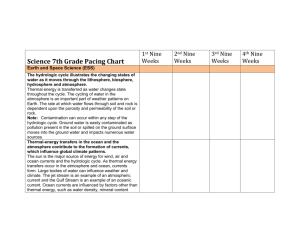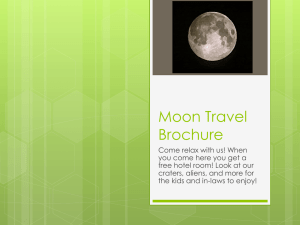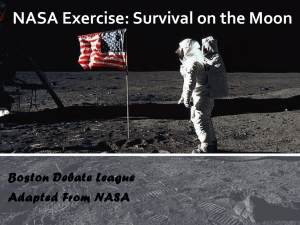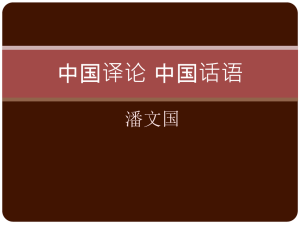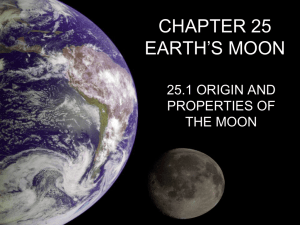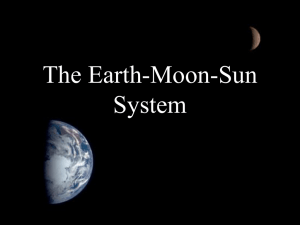Earth & Moon Review
advertisement
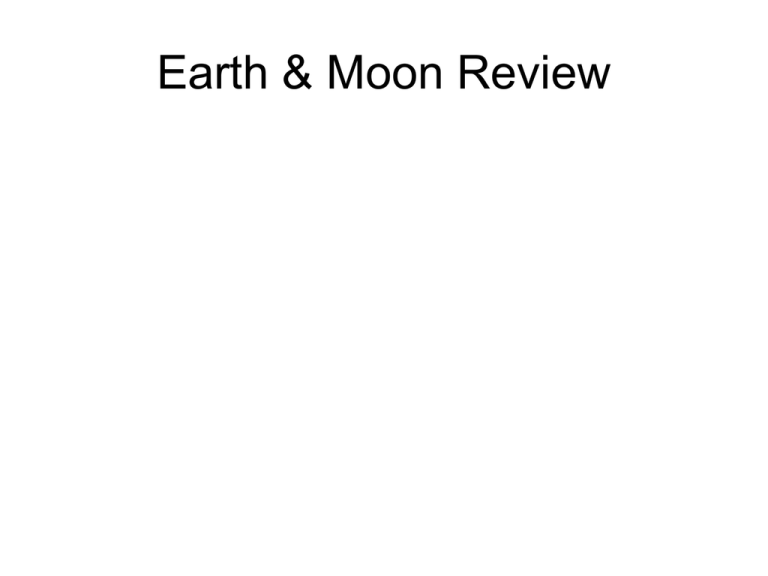
Earth & Moon Review Carbon 13 is a radioactive isotope. About half of a sample decays in 6000 years. After how long would only 1/8 of the original carbon 13 be left? A. 6,000 years B. 18,000 years C. 24,000 years D. 30,000 years . From the center outward, the correct order of the zones of the Earth is A. Solid core, mantle, liquid core, crust, atmosphere B. Liquid core, solid core, crust, mantle, atmosphere C. Solid core, liquid core, mantle, crust, atmosphere D. Liquid core, solid core, mantle, crust, atmosphere Why is the Earth’s magnetosphere important? A. B. C. D. It protects us from UV It traps heat It protects us from solar wind particles It makes our compasses work What are the two most abundant gases in Earth’s atmosphere? A. B. C. D. Oxygen: 78%; Nitrogen: 21% Nitrogen: 78%; Oxygen: 21% Carbon Dioxide: 78%; Oxygen: 21% Oxygen:78%; Carbon Dioxide: 21% In Earth’s atmosphere, as altitude increases, air pressure…. A. Increases B. Decreases C. Remains the same Which pair are greenhouse gases? A. B. C. D. Carbon dioxide & ozone Carbon dioxide & water vapor Nitrogen & oxygen Water vapor & ozone Convection is A. B. C. D. Heat transfer in a liquid or gas Heat transfer by direct contact Heat transfer by electromagnetic waves Heat transfer by magic The ozone layer is important to life because A. B. C. D. It traps heat It absorbs UltraViolet radiation It protects us from solar wind particles It provides gravity What drives the plate motion of Earth’s crust? A. B. C. D. Radiation Conduction Convection Erosion What is needed for convection? A. B. C. D. Erosion Evolution Magnetic field Heat source Where did most of Earth’s present atmosphere come from? A. B. C. D. solar wind Volcanic outgassing & plants Ozone depletion Greenhouse effect How do we know that Earth has layers? A. We’ve dug to the core B. We use X-rays to see through the layers C. We see layers in other planets and assume we have layers, too D. We see how seismic waves behave and interpret layer boundaries from them What causes a magnetic field around a planet? A. B. C. D. Liquid metal core & rapid rotation Auroras Meteors Solar wind and rotation The Coriolis Effect … A. Makes pressure systems circulate because of Earth’s rotation B. Makes pressure systems circulate because of Earth’s proximity to the sun C. Makes pressure systems circulate because of solar wind D. Makes pressure systems circulate because of Earth’s gravity Earth is a differentiated planet because A. The temperature in the core is higher than the temperature on the surface B. The material in the interior of the Earth is separated by density C. Iron is more dense than silicate material D. The Earth's structure is different from the other planets Which of Earth’s layers is densest? A. B. C. D. Inner core Outer core Mantle Crust Why does Earth’s surface differ from the moon’s surface? A. Earth has not been hit by meteors but the moon has been hit. B. Earth has an atmosphere that protects it from impacts. The moon does not. C. Earth has a magnetic field that deflects meteors. The moon does not. D. Earth has tectonic activity and repaves itself. The moon does not. Earth’s greenhouse effect… A. B. C. D. Allows for liquid water and life to exist. Protects us from UV rays Causes the Coriolis Effect Is caused by humans Why do we see only one side of the moon from Earth? A. The moon does not rotate B. The side of the moon facing us is the only one that gets light C. The moon rotates & revolves at the same rate D. The Earth does not rotate What causes tides? A. Earth’s rotation B. Earth’s revolution C. Coriolis Effect D. Earth’s moon How many high tides are there each day? A. B. C. D. 1 2 3 4 If the first high tide on Monday is at 10:00am, What time will the first high tide be on Tuesday? A. B. C. D. 10:00 am 10:00pm 10:50 am 10:30 am Highlands? A B D C Rays? A B D C Maria? A B D C Why does the moon have extreme temperatures? A. B. C. D. It has a carbon dioxide atmosphere It has a magnetic field It is close to the sun It has no atmosphere Why does the moon have no atmosphere? A. B. C. D. There is no life It’s made of the wrong kind of rocks There is no water to evaporate There is not enough gravity to hold gases How do we know the age of Earth’s rocks and the moon’s rocks? A. B. C. D. By the radioactive decay of isotopes By inspection By chemical analysis By amount of erosion


